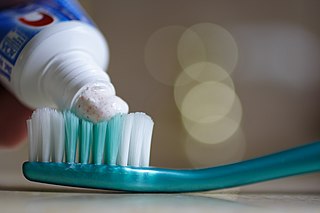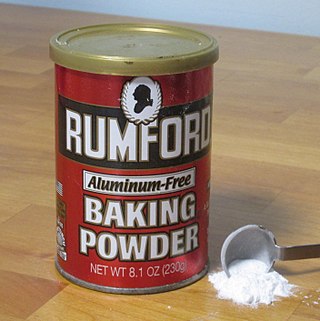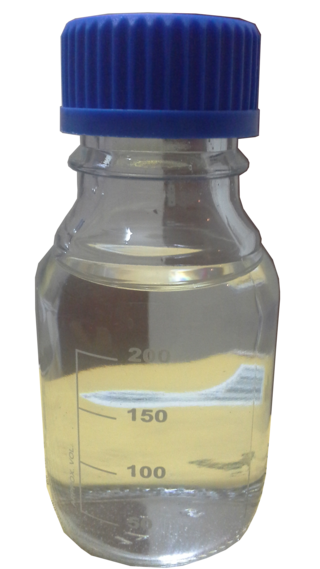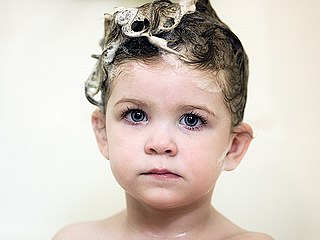Related Research Articles

Infant formula, also called baby formula, simply formula, baby milk or infant milk, is an ultra-processed food designed and marketed for feeding to babies and infants under 12 months of age, usually prepared for bottle-feeding or cup-feeding from powder or liquid. The U.S. Federal Food, Drug, and Cosmetic Act (FFDCA) defines infant formula as "a food which purports to be or is represented for special dietary use solely as a food for infants by reason of its simulation of human milk or its suitability as a complete or partial substitute for human milk".

Toothpaste is a paste or gel dentifrice used with a toothbrush to clean and maintain the aesthetics and health of teeth. Toothpaste is used to promote oral hygiene: it is an abrasive that aids in removing dental plaque and food from the teeth, assists in suppressing halitosis, and delivers active ingredients to help prevent tooth decay and gum disease (gingivitis). Owing to differences in composition and fluoride content, not all toothpastes are equally effective in maintaining oral health. The decline of tooth decay during the 20th century has been attributed to the introduction and regular use of fluoride-containing toothpastes worldwide. Large amounts of swallowed toothpaste can be poisonous. Common colors for toothpaste include white and blue.

Sodium bicarbonate (IUPAC name: sodium hydrogencarbonate), commonly known as baking soda or bicarbonate of soda, is a chemical compound with the formula NaHCO3. It is a salt composed of a sodium cation (Na+) and a bicarbonate anion (HCO3−). Sodium bicarbonate is a white solid that is crystalline, but often appears as a fine powder. It has a slightly salty, alkaline taste resembling that of washing soda (sodium carbonate). The natural mineral form is nahcolite. It is a component of the mineral natron and is found dissolved in many mineral springs.

Laxatives, purgatives, or aperients are substances that loosen stools and increase bowel movements. They are used to treat and prevent constipation.

Baking powder is a dry chemical leavening agent, a mixture of a carbonate or bicarbonate and a weak acid. The base and acid are prevented from reacting prematurely by the inclusion of a buffer such as cornstarch. Baking powder is used to increase the volume and lighten the texture of baked goods. It works by releasing carbon dioxide gas into a batter or dough through an acid–base reaction, causing bubbles in the wet mixture to expand and thus leavening the mixture. The first single-acting baking powder was developed by food manufacturer Alfred Bird in England in 1843. The first double-acting baking powder, which releases some carbon dioxide when dampened and later releases more of the gas when heated by baking, was developed by Eben Norton Horsford in the U.S. in the 1860s.

Lactitol is a disaccharide sugar alcohol produced from lactose. It is used as a replacement bulk sweetener for low calorie foods with 30–40% of the sweetness of sucrose. It is also used medically as a laxative.

Baby colic, also known as infantile colic, is defined as episodes of crying for more than three hours a day, for more than three days a week, for three weeks in an otherwise healthy child. Often crying occurs in the evening. It typically does not result in long-term problems. The crying can result in frustration of the parents, depression following delivery, excess visits to the doctor, and child abuse.

Oral rehydration therapy (ORT) is a type of fluid replacement used to prevent and treat dehydration, especially due to diarrhea. It involves drinking water with modest amounts of sugar and salts, specifically sodium and potassium. Oral rehydration therapy can also be given by a nasogastric tube. Therapy should routinely include the use of zinc supplements. Use of oral rehydration therapy has been estimated to decrease the risk of death from diarrhea by up to 93%.

The nutrition facts label is a label required on most packaged food in many countries, showing what nutrients and other ingredients are in the food. Labels are usually based on official nutritional rating systems. Most countries also release overall nutrition guides for general educational purposes. In some cases, the guides are based on different dietary targets for various nutrients than the labels on specific foods.

Milk allergy is an adverse immune reaction to one or more proteins in cow's milk. Symptoms may take hours to days to manifest, with symptoms including atopic dermatitis, inflammation of the esophagus, enteropathy involving the small intestine and proctocolitis involving the rectum and colon. However, rapid anaphylaxis is possible, a potentially life-threatening condition that requires treatment with epinephrine, among other measures.

Creamola Foam was a soft drink produced in the form of effervescent crystals that were mixed with water. It was manufactured in Glasgow and sold in the UK from the 1950s, until Nestlé ended production in October 1998.

Hydrocodone/paracetamol is the combination of the pain medications hydrocodone and paracetamol (acetaminophen). It is used to treat moderate to severe pain. It is taken by mouth. Recreational use is common in the United States.

Breath Savers is a brand of mint manufactured by the Hershey Company.

Macrogol, also known as polyethylene glycol (PEG), is used as a medication to treat constipation in children and adults. It is taken by mouth. Benefits usually occur within three days. Generally it is only recommended for up to two weeks. It is also used as an excipient. It is also used to clear the bowels before a colonoscopy, when the onset of the laxative effect is more rapid, typically within an hour.

Cleaning agents or hard-surface cleaners are substances used to remove dirt, including dust, stains, foul odors, and clutter on surfaces. Purposes of cleaning agents include health, beauty, removing offensive odor, and avoiding the spread of dirt and contaminants to oneself and others. Some cleaning agents can kill bacteria and clean at the same time. Others, called degreasers, contain organic solvents to help dissolve oils and fats.

Shampoo is a hair care product, typically in the form of a viscous liquid, that is used for cleaning hair. Less commonly, shampoo is available in solid bar format. Shampoo is used by applying it to wet hair, massaging the product into the scalp, and then rinsing it out. Some users may follow a shampooing with the use of hair conditioner.

The management of dehydration typically involves the use of oral rehydration solution (ORS). Standard home solutions such as salted rice water, salted yogurt drinks, vegetable and chicken soups with salt can be given. Home solutions such as water in which cereal has been cooked, unsalted soup, green coconut water, weak tea (unsweetened), and unsweetened fresh fruit juices can have from half a teaspoon to full teaspoon of salt added per liter. Clean plain water can also be one of several fluids given. There are commercial solutions such as Pedialyte, and relief agencies such as UNICEF widely distribute packets of salts and sugar. The World Health Organization (WHO) describes a homemade ORS with one liter water with one teaspoon salt and six teaspoons sugar added. The WHO; however, does not generally recommend homemade solutions as how to make them is easily forgotten. Rehydration Project recommends adding the same amount of sugar but only one-half a teaspoon of salt, stating that this more dilute approach is less risky with very little loss of effectiveness. Both agree that drinks with too much sugar or salt can make dehydration worse.
Parodontax is a brand name of toothpaste and mouthwash currently owned by Haleon, previously GSK.
References
- 1 2 3 Jain K, Gunasekaran D, Venkatesh C, Soundararajan P (2015). "Gripe Water Administration in Infants 1–6 months of Age-A Cross-sectional Study". J Clin Diagn Res. 9 (11): SC06–8. doi:10.7860/JCDR/2015/13727.6738. PMC 4668494 . PMID 26673749.
- ↑ Roberts, Donna M.; Ostapchuk, Michael; O'Brien, James G. (August 15, 2004). "Infantile Colic". American Family Physician . 70 (4): 735–40. PMID 15338787 . Retrieved August 18, 2015.
- 1 2 3 Adhisivam, B. (2012). "Is Gripe Water Baby-Friendly?". Journal of Pharmacology & Pharmacotherapeutics. 3 (2): 207–08. doi: 10.4103/0976-500X.95544 (inactive 31 January 2024). PMC 3356971 . PMID 22629105.
{{cite journal}}: CS1 maint: DOI inactive as of January 2024 (link) - ↑ Illingworth, C.; Timmins, J. (1990). "Gripe Water: What Is It? Why Is It Given?". Health Visitor . 63 (11): 378. PMID 2266018.
- 1 2 3 4 5 6 Blumenthal, Ivan (April 2000). "The Gripe Water Story". Journal of the Royal Society of Medicine. 93 (4): 172–74. doi:10.1177/014107680009300404. PMC 1297971 . PMID 10844880.
- ↑ Onwhyn, J (January–April 1898). "Notes, Short Comments, and Answers to Correspondents". The Lancet. 1 (Part 1): 414–416. doi:10.1016/s0140-6736(01)98389-8.
- ↑ FDA Import Alert # 66-41
- ↑ Zimmerman, DR (1992). Zimmerman's Complete Guide to Nonprescription Drugs. Visible Ink Press. ISBN 0-8103-8874-X.
- ↑ Lauren Feder, MD (2005). Natural Baby and Childcare. Hatherleigh. p. 432.
- ↑ "Wellements Introduces First-to-Market Probiotic Gripe Water". 2016-08-22.
- ↑ "GUIDELINES FOR THE IDENTIFICATION AND MANAGEMENT OF LEAD EXPOSURE IN PREGNANT AND LACTATING WOMEN" (PDF). CDC.gov.